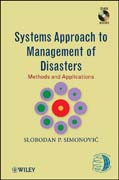
Systems approach to management of disasters: methods and applications
Simonoviae, Slobodan P.
The main goal of this text is to introduce the systems approach to disasters management community as an alternative approach that can provide support for interdisciplinary activities involved in the management of disasters. The systems approach draws on the fields of operations research and economics to createskills in solving complex management problems. The text is organized into four parts. Part I provides an introductory discussion of disaster management including an overview of the main terms used. Part II is devoted to the introduction of systems theory, mathematical formalization and classification of methods. The material presented in this section should be of practical relevance during the process of selecting an appropriate tool for the solution of a problem. Part III is technical in nature, providing a simulation approach and a detailed description of system dynamics simulation. This section details two areas of application: flood evacuation simulation, and disaster risk assessment. Part IV ends with a chapter covering steps to improve disaster management. Finally parts of the book can be used as a tool for specialized short courses for practitioners. For example a course on 'System analysis for emergency managementoptimization' could be based on Chapters 3, 4 and parts of Chapter 6. INDICE: "List of Figures and Tables. About the Author. Foreword. Preface. List of Acronyms and Abbreviations. I MANAGEMENT OF DISASTERS. 1 Introduction.1.1 Issues in Management of DisastersPersonal Experience. 1.1.1 Red River Flooding. 1.1.2 ""Red River Flood of the Century,"" Manitoba, Canada. 1.2 Tools for Management of DisastersTwo New Paradigms. 1.2.1 The Complexity Paradigm. 1.2.2 The Uncertainty Paradigm. 1.3 Conclusions. 2 Integrated Disaster Management. 2.1 Definition. 2.2 Integrated Disaster Management Activities. 2.2.1 Mitigation. 2.2.2 Preparedness. 2.2.3 Response. 2.2.4 Recovery. 2.3 Disaster Management in CanadaBrief Overview. 2.3.1 Emergency Management Act. 2.3.2 National Disaster Mitigation Strategy. 2.3.3 Joint Emergency Preparedness Program. 2.3.4 Emergency Response. 2.3.5 The Role of Federal Government in Disaster Recovery.2.4 Decision Making and Integrated Disaster Management. 2.4.1 Individual Decision Making. 2.4.2 Decision Making in Organizations. 2.4.3 Decision Making in Government. 2.5 Systems View of Integrated Disaster Management. II SYSTEMS ANALYSIS FOR INTEGRATED MANAGEMENT OF DISASTERS. 3 Systems Thinking and Integrated Disaster Management. 3.1 System Definitions. 3.1.1 What is a System? 3.1.2 Systems Thinking. 3.1.3 Systems Analysis. 3.1.4 The Systems Approach. 3.1.5 Systems ""Engineering"". 3.1.6 Feedback. 3.1.7 Mathematical Modeling. 3.1.8 A Classification of Systems. 3.1.9 A Classification of Mathematical Models. 3.2 Systems View of Integrated Disaster Management. 3.2.1 A Systems Typology in Integrated Disaster Management. 3.2.2 Systems View of Disaster Management. 3.2.3 Systems View of Disaster Management Activities. 3.3 System Formulation Examples.3.3.1 Dynamics of Epidemics. 3.3.2 Shortest Supply Route. 3.3.3 Resources Allocation. 4 Introduction to Methods and Tools for a Systems Approach to Management of Disaster. 4.1 Simulation. 4.2 System Dynamics Simulation. 4.3 Optimization. 4.4 Multiobjective Analysis. 4.5 Disaster Risk Management. 4.5.1 Sources of Uncertainty. 4.5.2 Conceptual Risk Definitions. 4.5.3 Probabilistic Approach. 4.5.4 A Fuzzy Set Approach. 4.6 Computer Support: Decision Support Systems.III IMPLEMENTATION OF SYSTEMS ANALYSIS TO MANAGEMENT OF DISASTERS. 5 Simulation. 5.1 Definitions. 5.2 System Dynamics Simulation. 5.2.1 Introduction. 5.2.2System Structure and Patterns of Behavior. 5.3 System Dynamics Simulation Modeling Process. 5.3.1 Causal Loop Diagram. 5.3.2 Stock and Flow Diagram. 5.3.3 Generic Principles of System Dynamics Simulation Modeling. 5.3.4 Numerical Simulation. 5.3.5 Policy Design and EvaluationModel Use. 5.4 System Dynamics Simulation Modeling Examples. 5.4.1 A Simple Flu Epidemic Model. 5.4.2 A More Complex Flu Epidemic Model with Recovery. 5.5 An Example of Disaster Management SimulationFlood Evacuation Simulation Model. 5.5.1 Introduction. 5.5.2 Human Behavior During Disasters. 5.5.3 A System Dynamics Simulation Model. 5.5.4 Application of the Evacuation Model to the Analyses of Flood Emergency Procedures inthe Red River Basin, Manitoba, Canada. 5.5.5 Conclusions. 6 Optimization. 6.1Linear Programming. 6.1.1 Formulation of Linear Optimization Models. 6.1.2 Algebraic Representations of Linear Optimization Models. 6.2 The Simplex Method for Solving Linear Programs. 6.2.1 Completeness of the Simplex Algorithm. 6.2.2 The Big M Method. 6.3 Duality in LP. 6.3.1 Sensitivity Analysis. 6.4 SpecialTypes of LP ProblemsTransportation Problem. 6.4.1 Formulation of the Transportation Problem. 6.4.2 Solution of the Transportation Problem. 6.5 Special Types of LP ProblemsNetwork Problems. 6.5.1 The Shortest Path Problem. 6.5.2 The Minimum Spanning Tree Problem. 6.5.3 The Maximum Flow Problem. 6.6 An Example of Disaster Management OptimizationThe Optimal Placement of Casualty EvacuationAssets. 6.6.1 Introduction. 6.6.2 The OPTEVAC Model. 6.6.3 A Casualty Evacuation Example. 6.6.4 Summary. 7 Multiobjective Analysis. 7.1 Introduction. 7.1.1Toward Operational Framework for Multiobjective Analysis. 7.1.2 An Illustrative Example. 7.2 Multiobjective Analysis Methodology. 7.2.1 Change of Concept. 7.2.2 Nondominated Solutions. 7.2.3 Participation of Decision Makers. 7.2.4 Classification of Multiobjective Techniques. 7.2.5 Disaster Management Applications. 7.3 The Weighting Method. 7.4 The Compromise Programming Method. 7.4.1 Compromise Programming. 7.4.2 Some Practical Recommendations. 7.4.3 The COMPRO Computer Program. 7.5 An Example of Disaster Management Multiobjective AnalysisSelection of Flood Management Alternative. 7.5.1 Preparation of Input Data. 7.5.2 Solution of Flood Management Problem Using Compromise Programming. 7.5.3 Summary. References. Exercises. IV BE PREPARED. 8 A View Ahead. 8.1 Issues in Future Disaster Management. 8.1.1 Climate Change. 8.1.2 Population Growth and Migrations. 8.2 A Systems View. References. Index. "
- ISBN: 978-0-470-52809-9
- Editorial: John Wiley & Sons
- Encuadernacion: Cartoné
- Páginas: 348
- Fecha Publicación: 10/12/2010
- Nº Volúmenes: 1
- Idioma: Inglés
